



Borden's Towne Marker
100 Crosswicks St.
In front of Clara Barton School
Map / Directions to the Borden's Towne Marker
Map / Directions to all Bordentown Revolutionary War Sites
This area was first settled in 1682 and was originally called Farnsworth Landing. In 1717, Joseph Borden bought up much of the property, and the town was renamed Borden's Towne, and later Bordentown. A plaque in front of Clara Barton school commemorates some of the Revolutionary War activity that took place in Bordentown.
Before the Battle of Trenton — December 1776 [1]
On November 19, 1776, British and Hessian forces invaded New Jersey, disembarking at Huyler's Landing in Bergen County. At the time, General George Washington and the Continental (American) army were in nearby Fort Lee. Washington's army had recently suffered a string of defeats in New York city. Upon learning of the landing of the British and Hessian troops at Alpine Landing, the Continental Army began a retreat across New Jersey that ended when they crossed over the Delaware River into Pennsylvania on December 2.
While the Continental Army was on the Pennsylvania side of the Delaware River, British and Hessian forces occupied a number of towns throughout New Jersey. Soldiers under the command of Hessian Colonel Carl von Donop occupied Bordentown at this time.
Six miles to the north of Bordentown, Hessian Troops under the command of Colonel Johann Rall occupied Trenton.
The Hessian troops at Bordentown were drawn south towards Mount Holly to engage with a small group of American troops under the command of Samuel Griffin. They fought the Petticoat Bridge Skirmish on December 22 and the Battle of Iron Works Hill the following day.
Following the Battle of Iron Works Hill, the Hessians remained in Mount Holly for several days, instead of returning to Bordentown. This placed them eighteen miles away from Trenton, rather than six miles if they had returned to Mount Holly. As a result, they were too far away from Trenton to be of any assistance to the Hessians there when Washington's troops attacked Trenton after their famous crossing of the Delaware River on Christmas night. The American victory at the Battle of Trenton helped to turn the tide of the war.
British Raid — May 8, 1778 [2]
British forces invaded Philadelphia September 26, 1777, and began an occupation of the city which lasted until the following June. Towards the end of this occupation, they mounted a raid of Bordentown and neighboring White Hill (now Fieldsboro).
On the night of May 7, 1778, the British sent a band of infantry troops by ship up the Delaware River. The following morning, they disembarked about thirty miles up the Delaware River near White Hill. At White Hill they encountered a group of American militia. The militia were dispersed by the British troops, who pursued them into Bordentown.
Great damage was done during this raid. Buildings and American military supplies were burned, and American ships in the waters alongside Bordentown and White Hill were destroyed. See the May 8, 1778 British Raid Marker and Colonel Joseph Borden House entries below on this page for more about the damage done.
Before the Battle of Monmouth — June 23, 1778 [3]
On June 18, 1778, the British troops in Philadelphia abandoned the city. They crossed over the Delaware River into New Jersey at Coopers Ferry (now Camden) and began a march across New Jersey towards New York City, the main British stronghold in America throughout the Revolutionary War. They marched on a path through Haddonfield, Cherry Hill, Mount Laurel, Moorestown, Mount Holly, Bordentown, Crosswicks, Upper Freehold and Monmouth Courthouse (now Freehold). On June 28, they encountered the Continental (American) Army at Monmouth Courthouse and fought the Battle of Monmouth, the longest sustained battle of the Revolutionary War.
It was on June 23 during this march that British troops came through Bordentown. They did further damage to this area, which had been raided just six weeks before. Among the damaged property was a large mill on the Black Creek, owned by a merchant named Nathaniel Lewis. (Black's Creek runs along to the east of modern-day Route 295, from the Delaware River.)
Four months later, Nathaniel Lewis ran a notice in the New-Jersey Gazette that he was selling the destroyed mill. The notice read in part: [4]
"FOR SALE — The ruins of a compleat merchant mill, (which was destroyed by the British army in their late march through New-Jersey) together with about 40 acres of Land, situate[d] on Black's creek, about half a mile from Borden-Town, in the county of Burlington, a healthy part of the country distant from Philadelphia 28 miles."



May 8, 1778 British Raid Marker
End of Prince St.
Map / Directions to the British Raid Marker
Map / Directions to all Bordentown Revolutionary War Sites
During the May 8, 1778 raid described above, American ships were destroyed in the waters alongside Bordentown. This historic marker commemorating the destroyed ships is located at the end of Prince Street, overlooking where Crosswicks Creek meets the Delaware River. [5]

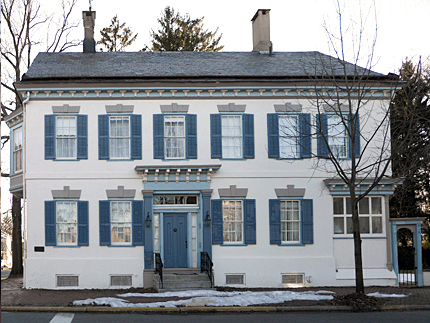

Colonel Joseph Borden Home
32 Farnsworth Ave.
Map / Directions to the Colonel Joseph Borden House
Map / Directions to all Bordentown Revolutionary War Sites
This house is a private residence.
Please respect the privacy and property of the owners.
This was the home of Colonel Joseph Borden (1719-1791). His father, also named Joseph, settled here in 1717 when the town was called Farnsworth Landing, renaming it Borden's Towne, and later Bordentown. The home was damaged when it was burned by the British in their May 8, 1778 raid, but then later restored. [6]
Joseph Borden played a number of roles, both political and military, during the Revolutionary War era. In 1765, he was one of three representatives for New Jersey for the Stamp Act Congress. [7] In 1775, he represented Burlington County in the Provincial Congress of New Jersey.[8] He was a colonel of militia early in the war,[9] and then served as the Continental loan officer for New Jersey. [10]


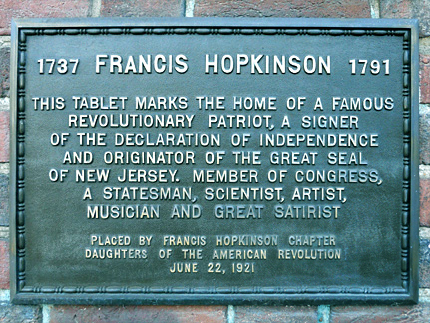
Francis Hopkinson House
101 Farnsworth Ave.
Now used as business offices
Map / Directions to the Francis Hopkinson House
Map / Directions to all Bordentown Revolutionary War Sites
This building was built in 1750. It was the home of Declaration of Independence signer Francis Hopkinson. He lived here with his wife Ann Borden from 1774 until his death in 1791. [11]
Hopkinson was one of five signers of the Declaration of Independence representing New Jersey. The other four were:
• Abraham Clark, whose house is in Roselle; his gravesite is in Rahway
• John Hart, whose house and gravesite are in Hopewell
• Richard Stockton, whose home, Morven, and his gravesite are both in Princeton
• John Witherspoon, who lived at the Maclean House in Princeton, and is buried at the Princeton Cemetery.

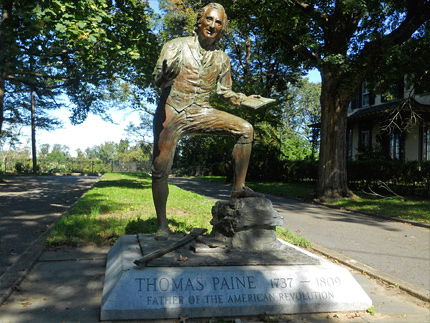
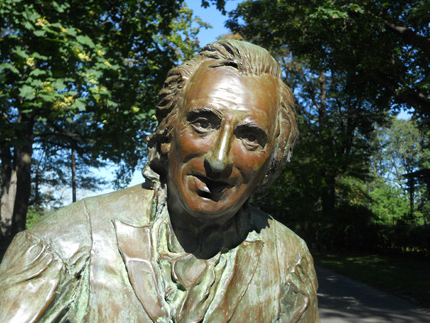
Thomas Paine Statue
Prince St. and Courtland St.
Map / Directions to the Thomas Paine Statue
Map / Directions to all Bordentown Revolutionary War Sites
Thomas Paine (February 9, 1737 — June 8, 1809) was the author of important pamphlets during the Revolutionary War. The first of these pamphlets, Common Sense, was published in early 1776; it helped move public opinion in the colonies towards Independence.
In July 1776, Paine joined up with the American Army, and in September became an aide to General Nathanael Greene. During this time he also acted as a war correspondent, sending his eyewitness accounts to be published in the Pennsylvania Journal.
Paine was with the American army at Fort Lee when they began their retreat across New Jersey. Traveling with the army as they retreated, he began writing the first of what would become a series of pamphlets titled The American Crisis (also known as The Crisis), which began with the now famous phrase, "These are the times that try men's souls." [12]
In 1783, Paine bought a house in Bordentown, where he lived at times until he died. (See Thomas Paine House entry below.) This statue, which was erected in 1997, pays tribute to Paine as a resident of Bordentown. It is one of two Thomas Paine statues in New Jersey; the other is in Morristown. The text on the four sides of this statue's base reads: [13]
Thomas Paine 1737-1809
Father of the American Revolution
"I had rather see my horse Button in his own stable, or eating the grass of Bordentown,
than see all the pomp and show of Europe." — Letter from Europe 1789
Paine's words and deeds put the concepts of independence, equality, democracy, abolition of slavery, representative government and a constitution with a bill of rights on the American agenda.
Paine considered Bordentown his home; it is here he invented his bridge.

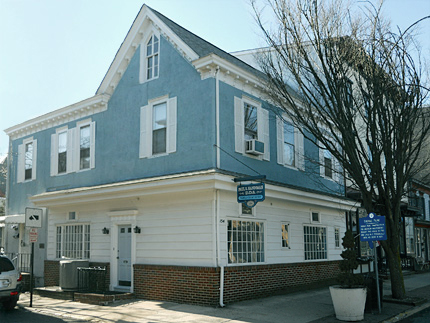

Thomas Paine House
154 Farnsworth Ave.
Now the Office of Dentist Paul S. Handman
Map / Directions to the Thomas Paine House
Map / Directions to all Bordentown Revolutionary War Sites
Thomas Paine's Bordentown house stands less than a half mile from the statue. The house is now used as a dentist's office. A historic sign in front notes that Paine "bought this house in 1783, and lived in it periodically until his death in 1809." [14]





Patience Lovell Wright House
100 Farnsworth Ave.
Map / Directions to the Patience Lovell Wright House
Map / Directions to all Bordentown Revolutionary War Sites
A Women's Heritage Trail plaque at the house tells about Patience Lovell Wright and her Revolutionary War story: [15]
"Patience Lovell Wright was America's first professional sculptor and a self-appointed Revolutionary War spy. A native of Bordentown, she lived in this house after her marriage to Joseph Wright in 1748. She learned from her sister, Rachel, how to sculpt wax figurines and the two women created wax exhibits, which they took on tour, receiving commissions for portraits. Patience Wright was the first American artist to focus on creating wax figurines of living figures, traveling to London to seek new subjects for her sculptures. While in London, Wright met Ben Franklin, who introduced her to many prominent members of London society, and she was commissioned to create sculptures of the king and queen of England. As relations worsened between England and America, Wright took it upon herself to become a spy and send information home to America hidden in wax heads. The only remaining full-size work of Wright's that exists today is a wax figure displayed in Westminster Abbey, London. Wright remained in England for the rest of her life."
Wright knew and corresponded with such important Revolutionary War figures as George Washington, Benjamin Franklin, John Adams and Thomas Jefferson. In a letter written from George Washington on January 20, 1785 (sixteen months after the official end of the Revolutionary War), Washington praised Wright and her talents: [16]
"if your inclination to return to this Country should overcome other considerations, you will, no doubt, meet a welcome reception from your numerous friends: among whom, I should be proud to see a person so universally celebrated; & on whom, nature has bestowed such rare & uncommon gifts."



Bordentown War Memorial Wall
Farnsworth Ave. and Railroad Ave.
Map / Directions to the Bordentown War Memorial
Map / Directions to all Bordentown Revolutionary War Sites
This is memorial to Bordentown veterans of all wars. The first section lists the names of Bordentown Revolutionary War soldiers: [17]
Joseph Adams
Edward Allan
Ell Anderson
Andrew Applegate
James Applegate
Abner Arey
Samuel Bailey
John Barnes
Zebulon Barton
James Bell
William Bennett
Aaron Biddle
Jacob Biddle
Moses Biddle
John Black
Philip Bound
Jesse Borden
Job Borden
John Borden
Joseph Borden, Jr.
Joseph Borden 3rd
Mathias Borden
William Borden
Benjamin Brown
Henry Brown
Peter Brown
John Brown *
John Brown *
John Brown, Jr.
Joseph Brown
Thomas Brown
William Brown
Zebulon Brown
John Bryant
Joseph Budd
William Budd
Abel Bunting
Ramoth Bunting
Isarel Carl
David Cavaleer
Zebulon Chambers
Zachariah Clevenger
John Clutch
Joel Cook
William Cook, Jr.
John Coward
Joseph Cox
Marmaduke Curtis
Thomas Curtis
Josiah Davis
Aaron Deacon
Alexander Douglass
John Douglass
John Douglass
John Dunn
William Dunn
Daniel Farnsworth
Benjamin Fenimore
James Fenimore
Samuel Fenimore
Thomas Fenimore
Richard R. Field
Thomas Field
William Ford
Samuel Forker
John Fort
John Foster
John Foulks
James Gamble
Samuel Gamble
Caleb Gaskill
Samuel Gaskill
Thomas Gibbs
William Gordon
William Grant
Thomas Haines
David Hall
John Hammill
Joseph Hankins
Isaac Harrison
William Hays
David Hendrickson
Oakey Hoagland
Joseph Howard
James Howell
Josiah Hunt
John Hutchinson
Thomas Hutchinson
Edward Isdell
Josiah Jenkins
Nathaniel Jenkins
John Johnson
John Jones
David Kelly
Jacob Kirby
Joseph Kirkbride
James Lanning
Benjamin Lawrence
Jacob Lawrence
John Lawrence
James Lawrie
William Lewis
Elias Longstreet
John Longstreet
Lott Lovelace
Ely Matthews
Levi Merritt
William Mershon
James Maxwell
Joel Middleton
John Middleton
Thomas Middleton
George Miles
Joseph Miller
Alexander Montgomery
James Murdock
Alexander Nelson
Theodore Newell
Silas Newton
John Norcross
William Norcross *
William Norcross *
John Oliver
William Oliver
Thomas Page
Joseph Pancoast
Abraham Parker
Isaac Parker
Joseph Parker
Thomas Parker
Jonathan Patterson
Daniel Pearson
John Pearson *
John Pearson *
Joseph Pearson
Joseph Porter
Thomas Potter
William Potts
Joseph Quigley
Robert Quigley
Moses Quigley
Thomas Quigley
James Raymond
Charles Read
Peter Reed
Anthony Reckless
Robert Reckless
Bowes Reed
John Reeves
Jacob Richardson
William Roads
William Rockhill
Richard Rose
John Salter, Jr.
John Salter, Sr.
John Schooley
Samuel Schooley
Benjamin Shreve
Caleb Shreve
Isarel Shreve
John Shreve *
John Shreve *
Joshua Shreve
Richard Shreve
William Shreve *
William Shreve *
Benjamin Smith
John Steward
Robert Sutton
John Taylor *
John Taylor *
Samuel Teal
Martin Thomas
Hambleton Thompson
Abram Tilton
Thomas Tobin
Jacob Trout
William Trout
John Vanemburgh
Joseph Vandyke
Barnabas Vansciver
John Watson *
John Watson *
William Watson
William Wilgus
John Wilkinson
John Wilson
C. Wood
John Wood
William Wood *
William Wood *
A. Woodward
Thomas Woodward
George M. Wright
James Wright
Thomas Wright
* The soldiers listed with duplicate names are not typos. In these cases, two men from Bordentown with the same name were Revolutionary War Veterans.

1. ^ For more information and accompanying sources about the British and Hessian's at Huyler's Landing, and the subsequent retreat of the Continental Army from nearby Fort Lee, see the Alpine and Fort Lee pages of this website.
For more information and accompanying sources about the Crossing of the Delaware River and the Battle of Trenton, see the Hopewell Township and Trenton pages of this website.
• Details about the Petticoat Bridge Skirmish and the Battle of Iron Works hill can be found in the following contemporary and secondary sources:
Captain Johann Ewald, Translated and edited by Joseph P. Tustin, Diary of the American War — A Hessian Journal (New Haven and London: Yale University Press, 1979) Pages 35 -42
Joseph Galloway, Letters to a Nobleman, on the Conduct of the War in the Middle Colonies (London: Printed for J. Wilkie, No. 71, St. Paul's Church-Yard, 1779) Pages 53-54
Available to be read at the Internet Archive hereJoseph Reed, "General Joseph Reed's Narrative of the Movements of the American Army in the Neighborhood of Trenton in the Winter of 1776-77," published in The Pennsylvania Magazine of History and Biography, Dec 1, 1884, Page 392
Available to be read at the Internet Archive herePennsylvania Evening Post, December 24, 1776, reprinted in:
William S. Stryker, editor, Archives of the State of New Jersey, Second Series, Vol. I (Documents Relating to the Revolutionary History of the State of New Jersey) (Trenton: John L. Murphy Publishing Company, 1901) Page 243
Available to be read at the Internet Archive hereWilliam M. Dwyer, The Day is Ours! (New York: Viking Press, 1983) Page 213 -217
William S. Stryker The Battles of Trenton and Princeton (Boston and New York: Houghton Mifflin and Company,1898) Pages 73 — 75
2. ^ For several contemporary accounts of the May 8, 1778 raid, see:
The Pennsylvania Ledger, May 13, 1778, as reprinted in:
Francis B. Lee, Editor Archives of the State of New Jersey, Second Series, Vol II (Documents Relating to the Revolutionary History of the State of New Jersey / Extracts from American Newspapers relating to New Jersey) (Trenton: John L. Murphy Publishing Company, 1903) Pages 217 -218
Available to be read at the Internet Archive here"Mr Collins, You are requested, as you esteem and value...," The New-Jersey Gazette, Vol. 1, No. 25, May 20, 1778, as reprinted in:
Francis B. Lee, Archives of the State of New Jersey, Second Series, Vol II (Documents Relating to the Revolutionary History of the State of New Jersey / Extracts from American Newspapers relating to New Jersey) (Trenton: John L. Murphy Publishing Company, 1903) Page 219
Available to be read at the Internet Archive hereNew-Jersey Gazette, Vol. 1, No. 30, June 24, 1778. Reprinted in:
Francis B. Lee, editor, Archives of the State of New Jersey, Second Series, Vol II (Documents Relating to the Revolutionary History of the State of New Jersey | Extracts from American Newspapers relating to New Jersey) (Trenton: John L. Murphy Publishing Company, 1903) Page 269
▸ The paragraph beginning with, "Previous to the evacuation of Philadelphia..."..." refers to the events of May 8, 1778
Available to be read at the Internet Archive here3. ^ New-Jersey Gazette, Vol. 1, No. 30, June 24, 1778. Reprinted in:
Francis B. Lee, editor, Archives of the State of New Jersey, Second Series, Vol II (Documents Relating to the Revolutionary History of the State of New Jersey | Extracts from American Newspapers relating to New Jersey) (Trenton: John L. Murphy Publishing Company, 1903) page 269
▸ The paragraph beginning with, "The enemy, on their way through Burlington County..." refers to the events of June 23, 1778
Available to be read at the Internet Archive here▸ ▸ For more information, and accompanying source notes about the June 1778 British march across New Jersey, and the Battle of Monmouth, see the pages linked within the text.
4. ^ New-Jersey Gazette, Vol. 1, No. 45, Oct. 14, 1778. Reprinted in:
Francis B. Lee, editor, Archives of the State of New Jersey, Second Series, Vol II (Documents Relating to the Revolutionary History of the State of New Jersey | Extracts from American Newspapers relating to New Jersey) (Trenton: John L. Murphy Publishing Company, 1903) Page 481-483
Available to be read at the Internet Archive here5. ^ This plaque was erected May 20, 1990 by Rancocas Valley Chapter — National Society Colonial Dames XVII Century. It states that "22 vessels at Bordentown and 4 at White Hill were among the 44 that were destroyed in a British raid on May 8, 1778."
A British account of the raid, which appears in the Pennsylvania Ledger five days after the raid, gives details about some of the ships destroyed:
▸ The Pennsylvania Ledger, May 13, 1778, as reprinted in:
Francis B. Lee, editor, Archives of the State of New Jersey, Second Series, Vol II (Documents Relating to the Revolutionary History of the State of New Jersey / Extracts from American Newspapers relating to New Jersey) (Trenton: John L. Murphy Publishing Company, 1903) Pages 217 -218
Available to be read at the Internet Archive here6. ^ The burning of Joseph Borden's property is mentioned in:
The New-Jersey Gazette, Vol. 1, No. 25, May 20, 1778, as reprinted in:
Francis B. Lee, Archives of the State of New Jersey, Second Series, Vol II (Documents Relating to the Revolutionary History of the State of New Jersey / Extracts from American Newspapers relating to New Jersey) (Trenton: John L. Murphy Publishing Company, 1903) Page 219
Available to be read at the Internet Archive here
▸ The date is not mentioned. However, since the newspaper was dated May 20, 1778, the burning must have occurred during the May 8 raid, and not the June 23 raid.7. ^ The Journal of the Stamp Act Congress lists Joseph Borden as one of the three delegates from New Jersey. (The other two delegates were Hendrick Fisher and Robert Ogden.) Reprinted in:
C. A. Weslager, The Stamp Act Congress (Newark, Delaware: University of Delaware Press, 1976) Page 1898. ^ Minutes of the Provincial Congress and the Council of Safety of the State of New Jersey (Trenton: Naar, Day & Naar, 1879) Pages 169-170, and 183-184
Available to be read at the Internet Archive here9. ^ William S. Stryker, Official Register of the Officers and Men of New Jersey in the Revolutionary War (Trenton: Wm. T. Nicholson & Co., 1872) Pages 350
Available to be read at Google Books hereMinutes of the Provincial Congress and the Council of Safety of the State of New Jersey (Trenton: Naar, Day & Naar, 1879) Page 569
Available to be read at the Internet Archive here10. ^ Robert Morris, edited by John Catanzariti and E. James Ferguson, The Papers of Robert Morris, 1781-1784 (Pittsburgh: University of Pittsburgh Press, 1984) Pages 30, 203, 328 and 341
Available to be read at Google Books here“To George Washington from William Livingston, 2 March 1778,” Founders Online, National Archives (http://founders.archives.gov/documents/Washington/03-14-02-0022 [last update: 2015-06-29]). Source: The Papers of George Washington, Revolutionary War Series, vol. 14, 1 March 1778 – 30 April 1778, ed. David R. Hoth. Charlottesville: University of Virginia Press, 2004, pp. 33–35.
▸In the P.S., Livingston mentions "Collo. Borden our Loan officer"11. ^ National Register of Historic Places / Inventory — Nomination Form for the Francis Hopkinson House
Available as a PDF on the National Park Service website here
▸ Those interested in architectural details about the building are recommended to this document.12. ^ For more information about Common Sense, and an analysis of whether Paine actually began writing it in New Jersey, see the Thomas Paine Monument entry on the Morristown page of this website and its accompanying Source Notes # 33 and 34 on that page.
13. ^ Text on the four sides of the base of the Thomas Paine statue. It also states that it was, "Dedicated to the People of Bordentown from the Bordentown Historical Society 6-7-97."
• The 'I had rather see my horse..." quote is from a letter written by Thomas Paine to Kitty Nicholson Few, January 6, 1789.
The passage of the letter the quote is drawn from reads:"You touch me on a very tender part when you say my friends on your side the water 'cannot be reconciled to the idea of my resigning my adopted America, even for my native England.' They are right. Though I am in as elegant style of acquaintance here as any American that ever came over, my heart and myself are 3000 miles apart; and I had rather see my horse Button in his own stable, or eating the grass of Bordentown or Morrisania, than see all the pomp and show of Europe."
At the end of the letter, Paine mentions Bordentown again:
"Remember me to the family at Morrisania, and all my friends at New York and Bordentown."
The full letter can be read on the website of the Thomas Paine Historical Association here
14. ^ State of New Jersey Historic sign
15. ^ Women's Heritage Trail sign, placed by Department of Community Affairs / New Jersey Historic Trust, and the Department of Environmental Protection / Historic Preservation Office
16. ^ “From George Washington to Patience Wright, 30 January 1785,” Founders Online, National Archives (http://founders.archives.gov/documents/Washington/04-02-02-0218 [last update: 2015-06-29]). Source: The Papers of George Washington, Confederation Series, vol. 2, 18 July 1784 – 18 May 1785, ed. W. W. Abbot. Charlottesville: University Press of Virginia, 1992, pp. 299–300.
• Other letters from Patience Lovell Wright are available at the Founders Online, National Archives website, including:
“To Benjamin Franklin from Patience Wright, [after 7 March 1777],” Founders Online, National Archives (http://founders.archives.gov/documents/Franklin/01-23-02-0291 [last update: 2015-06-29]). Source: The Papers of Benjamin Franklin, vol. 23, October 27, 1776, through April 30, 1777, ed. William B. Willcox. New Haven and London: Yale University Press, 1983, pp. 447–450.
“From Benjamin Franklin to Patience Wright, 4 May 1779,” Founders Online, National Archives (http://founders.archives.gov/documents/Franklin/01-29-02-0364 [last update: 2015-06-29]). Source: The Papers of Benjamin Franklin, vol. 29, March 1 through June 30, 1779, ed. Barbara B. Oberg. New Haven and London: Yale University Press, 1992, pp. 431–433.
“To John Adams from Patience Lovell Wright, [1 November 1783],” Founders Online, National Archives (http://founders.archives.gov/documents/Adams/06-15-02-0166 [last update: 2015-06-29]). Source: The Adams Papers, Papers of John Adams, vol. 15, June 1783–January 1784, ed. Gregg L. Lint, C. James Taylor, Robert F. Karachuk, Hobson Woodward, Margaret A. Hogan, Sara B. Sikes, Mary T. Claffey, and Karen N. Barzilay. Cambridge, MA: Harvard University Press, 2010, p. 337.
“To Thomas Jefferson from Patience Wright, 14 August 1785,” Founders Online, National Archives (http://founders.archives.gov/documents/Jefferson/01-08-02-0303 [last update: 2015-06-29]). Source: The Papers of Thomas Jefferson, vol. 8, 25 February–31 October 1785, ed. Julian P. Boyd. Princeton: Princeton University Press, 1953, pp. 380–381.
17. ^ List of Bordentown Revolutionary War soldiers from the Bordentown War Memorial Wall